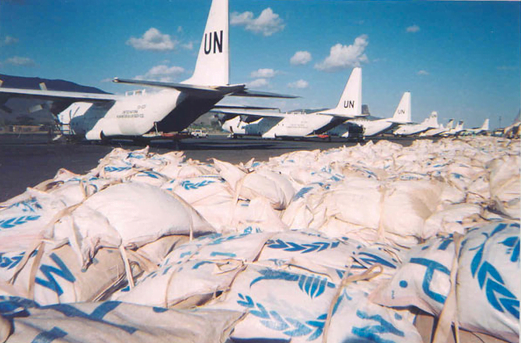

Today is World Food Day. Here are some vital statistics: there about 842 million hungry people on the planet. The vast majority of hungry people (827 million) live in developing countries, where 14.3 percent of the population is undernourished.
The World Food Program is the worlds largest humanitarian agency fighting hunger worldwide. This includes responding to some of the most complex emergencies in the world. Here are some more statistics: In Syria, the WFP is working to assist up to 6.5 million Syrians, including 4 million people inside Syria and almost 2.5 million refugees in neighboring countries. In Mali the WFP serves 530,000 people, including 400,000 people affected by conflict in the north. In all, the WFP serves 90 million beneficiaries in 70 countries.
But behind these numbers is a story that many people outside the UN don’t realize: the WFP does much, much more than simply deliver food to needy populations. It provides the logistical backbone for the entire global humanitarian emergency response system. When there’s a sudden natural disaster — when bridges are down and airports are destroyed or people in otherwise hard-to-reach places desperately need humanitarian assistance — the international community turns to the UN, and the UN turns to the World Food Program.
The WFP has the assets, technical expertise, and an institutional culture built around swiftly delivering aid anywhere it is needed on a moment’s notice. On any given day it operates more than 50 aircraft, 40 ships, and thousands of trucks (and even occasionally some Yaks). It runs the UN’s Humanitarian Air Service; can set up IT services within 48 hours of a disaster anywhere in the world; and has pre-positioned mechanics and spare parts on hand for its massive fleet of trucks, planes, and boats.
I’ve been told that in terms of global logistical capacity, the WFP is second only to the US military, which is stunning considering that the Pentagon’s budget ( $680 billion ) is about 170 times larger than the WFP’s annual budget of $4 billion, which is raised entirely through donations.
The entire UN system depends on WFP, so when there is a sudden and deeply complex and massive emergency like the crisis in Syria, there is fear that it may stretch the logistical capacity of the WFP, which in turn imperils humanitarian responses elsewhere around the globe.
Fortunately that does not seem to be the case for Syria. Last month, I put this question to WFP’s executive director Ertharin Cousin. She said that despite the enormous challenges posed by the Syrian crisis, the WFP is still able to carry out its lead role in managing the logistics of emergency response elsewhere. “WFPs reputation is the ability to get things from one place to the other,” said Cousin. “[Syria] does not affect our ability to perform in other parts of the global community.”
That is welcome news for the rest of the United Nations. And another reminder of the vital role played by the WFP in the international community’s emergency response system.
Here’s how you can lend the WFP a hand as it lends a hand in crises around the world.
